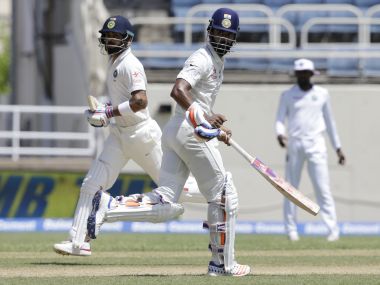Test cricket is in pretty rude health. For all the melodramatic pronouncements about the format’s imminent demise, things have rarely been this good. There are six very competitive teams, one team that seems to be in a period of almost continual transition, two that are struggling and one that is an out and out shambles. In the long and chequered history of Test cricket there has rarely been this number of teams that are capable of beating each other. One of those teams who are struggling, the West Indies, are playing India in a Test match at Sabina Park, Jamaica and it is a pretty joyless affair. Cricket does not necessarily need a close contest to be entertaining, some one-sided affairs are great to watch, but it does need some uncertainty and some thrills. [caption id=“attachment_2926760” align=“alignleft” width=“380”]  India’s KL Rahul and Virat Kohli build a partnership. AP[/caption] This Jamaica Test has given us none of that. The West Indies batted first on Day one and to the surprise of no one scored an under par 196. India began day two just 70 runs behind the West Indies and with nine wickets in hand. By the close they were 162 runs in front and they still had five wickets in the bank. What happened in between was very bland. The first session was painful as India scored their runs inevitably but slowly. There wasn’t a single boundary in the first 50 minutes of the day and it took Cheteshwar Pujara an hour to play his first scoring shot of day two. At the other end KL Rahul was in no rush, although he did bring up his hundred with a six. A lack of scoring shots does not always mean a lack of entertainment. In the recently concluded Test match between Sri Lanka and Australia, there was a world record 154 consecutive dot balls, but the match had something this Test did not – jeopardy. While the West Indies delivered the ball on a nagging line outside off-stump that kept things quiet they rarely looked like dismissing India’s batsmen who were more than happy to show Boycottian patience at the crease. It was not surprising that the first breakthrough of second day came via a run out, for the entire day up to that point it seemed like the only way the West Indies would make a breakthrough. Pujara tucked the ball off his legs and set off for a run that wasn’t really there. Roston Chase picked up the ball and threw in one fluid movement and ran out Pujara with a direct hit. Until then Pujara had been the very definition of concentration, making 46 runs from 159 balls, his partnership with Rahul worth 121 runs. It was, in truth, all a bit dull. That isn’t an attempt to be critical of India or the way they played the game, they did what needed to be done to put the game beyond their opponents. But that does not mean that it was a riveting spectacle from which you could not avert your eyes. You could have walked away when Rahul passed 100 knowing full well he would make it to 150. It is to the credit of this limited West Indies attack that has no real cutting edge that India’s batsmen did not race away, but it became clear very quickly that the best they could hope for was making it difficult for India to score rather than finding a way to bowl them out. In this series thus far the West Indies have claimed 13 Indian wickets while conceding 924 runs. The idea of the West Indies taking 20 wickets in one Test to win a match is nothing short of fanciful, and in this Test it was made even less likely when Miguel Cummins limped off the field clutching his hamstring. Rahul was brilliant throughout. When the ball was there to be attacked he did just that. He faced 303 balls in the innings but struck 15 fours and three sixes. He certainly wasn’t shotless. Again, he just did what he had to do for his team. Test cricket lasts a really long time, there is rarely a point where you have to rush. But it was a bit boring. Impressive, but still boring. When Rahul did fall, it was a bit of a strangle, edging the ball down the legside off Shannon Gabriel. Umpire Aleem Dar referred the decision to the TV umpire to see if the ball had carried. Rather confusingly when it was clearly shown on replay to have been cleanly caught they continued looking at different angles, seemingly to see if there had been an edge. With the Indian authorities still refusing to use DRS in bilateral series this was clearly outside of the umpire’s remit. Still, it gave us something to talk about on a day where there was precious little to hold your interest outside seeing how far Rahul could push his high score in Tests. Just when it seemed that nothing could save us from the tedium of day two at Jamaica, Virat Kohli finally made it a bit interesting when he smacked a few boundaries before almost inexplicably getting out to very gentle off-spin of Chase. While attempting to work the ball off his hips for a single he gave Rajendra Chandrika the easiest catch at forward short leg he will ever be offered. You can always rely on Kohli. The day finally came to an end. Frighteningly, there are 270 overs left in this match and when the West Indies get a chance they will need to bat far better than they have at any point in this series so far to get anything other than another defeat from it. If they do lose let’s hope they find an entertaining way to do it.
Test cricket is in pretty rude health. For all the melodramatic pronouncements about the format’s imminent demise, things have rarely been this good. There are six very competitive teams, one team that seems to be in a period of almost continual transition, two that are struggling and one that is an out and out shambles. In the long and chequered history of Test cricket there has rarely been this number of teams that are capable of beating each other.
Advertisement
End of Article


)

)
)
)
)
)
)
)
)



